
Vandenberg and the space shuttle (part 2)by Dwayne A. Day
|
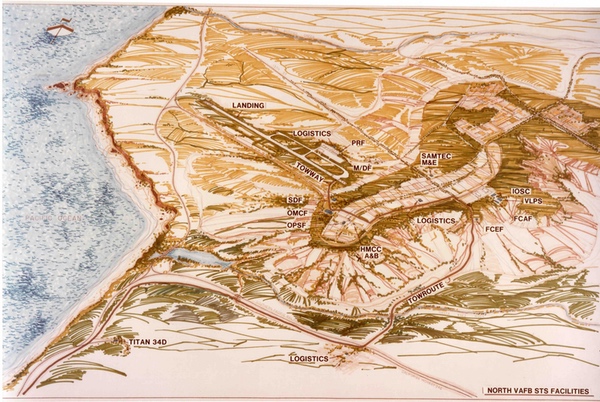 Most of the existing facilities at Vandenberg were located at the main base, and that is where most of the new infrastructure to support the shuttle was built. This was several kilometers north of the SLC-6 launch pad. (credit: USAF) |
The decision to use SLC-6 for shuttle launches created some design difficulties. SLC-6 was located at the far south of the base, and most other base infrastructure was several kilometers to the north. The pad complex also had mountains to the east and the Pacific Ocean to the west, and a railroad line that predated the base running through the area. Many new shuttle support facilities were therefore constructed on the main base, and the connecting infrastructure, including a road for towing an orbiter to the launch site, required modification.
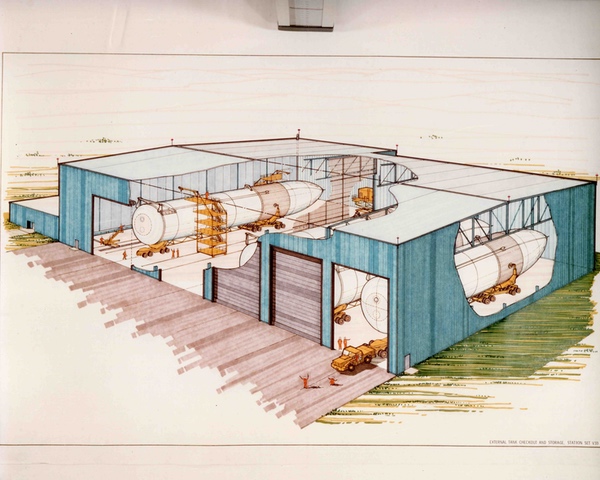 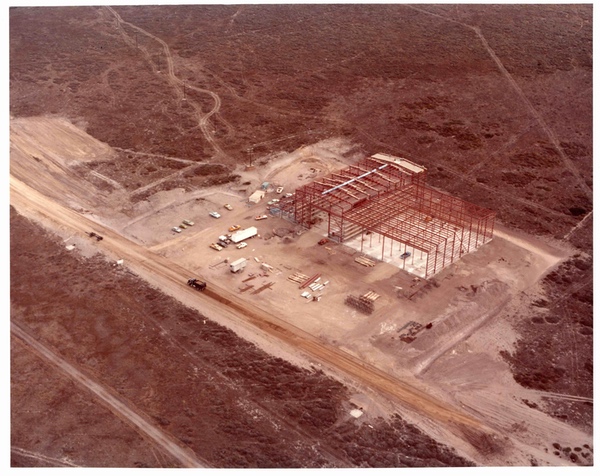 Vandenberg had a requirement to have several External Tanks on hand in case for some reason the Panama Canal became unusable. An External Tank Checkout and Storage facility was built, capable of supporting four tanks in storage and one in servicing. Several tanks were stored at the completed facility when the Air Force canceled Vandenberg shuttle launches. They were eventually transported to Florida. (credit: USAF) |
The shuttle would require an External Tank Checkout and Storage Facility to hold up to four of the large shuttle tanks while processing a fifth. The requirement to store four tanks was due to concerns that in a war, the Panama Canal could be closed and there would be no easy way to get tanks to the West Coast. At one point, several tanks were in storage at the facility, and after the decision was made to cancel Vandenberg shuttle launches, they were eventually transferred back to the East Coast. The tanks required a dock facility so they could be brought to Vandenberg by barge, and modifications to the roads so that they could be transported to the launch pad.
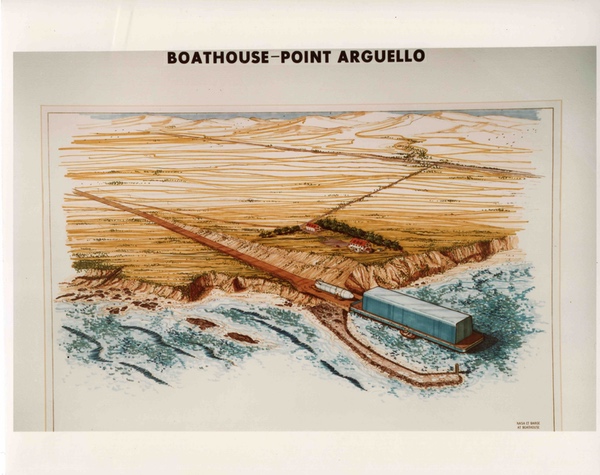 Vandenberg's boat house dates to a time when a Coast Guard rescue station was located there. A dock structure would be added to support bringing in the External Tanks and Solid Rocket Boosters for the shuttle. (credit: USAF) |
Additional buildings at Vandenberg were also necessary to support the shuttle’s Solid Rocket Boosters (SRBs). These included a Parachute Refurbishment Facility for the parachutes that lowered the SRBs to the ocean. A facility for handling the recovery of the SRBs would be built at Port Hueneme, farther south.
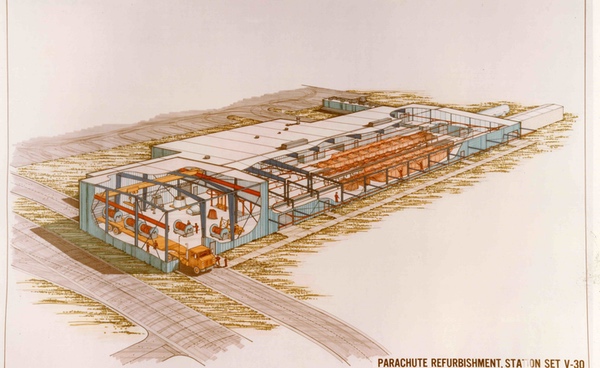 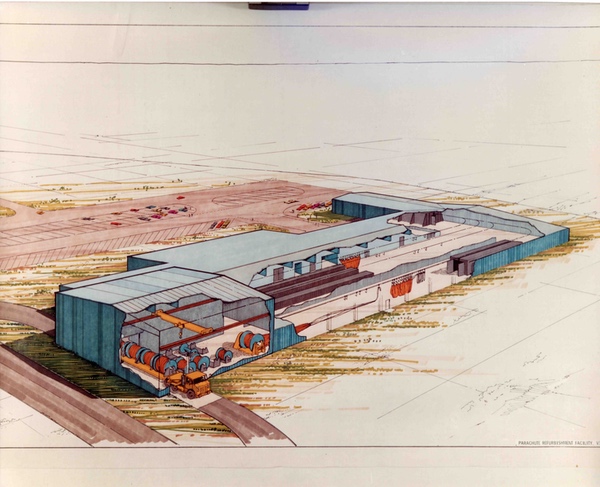 Not all of the shuttle's unique attributes were high tech. At Vandenberg there were plans to refurbish the parachutes that lowered the Solid Rocket Boosters to the ocean after jettison. (credit: USAF) |
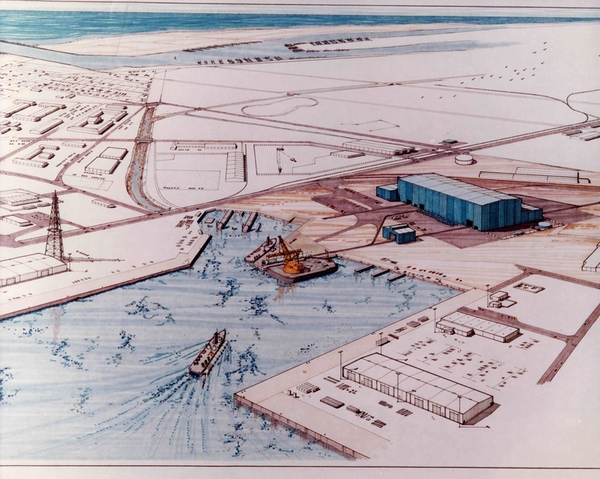 The shuttle's Solid Rocket Boosters would be towed to Port Hueneme, south of the base, and disassembled. (credit: USAF) |
The base’s existing runway was lengthened to enable shuttle landings and to accommodate the Shuttle Carrier Aircraft (SCA), a converted 747 that carried the shuttle on its back. Areas around the runway needed to be expanded to support a skeletal mate/demate device for lifting the shuttle onto the back of the SCA and to enable the shuttle to be towed from the runway to the launch site to the south.
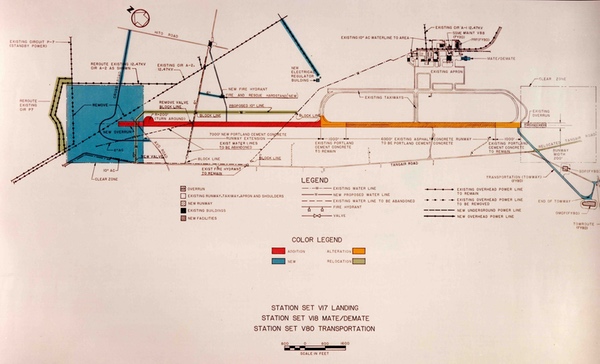 Vandenberg already had a runway to support operations. For shuttle this would have to be lengthened significantly and other parts, such as a tow way, would have to be added. (credit: USAF) |
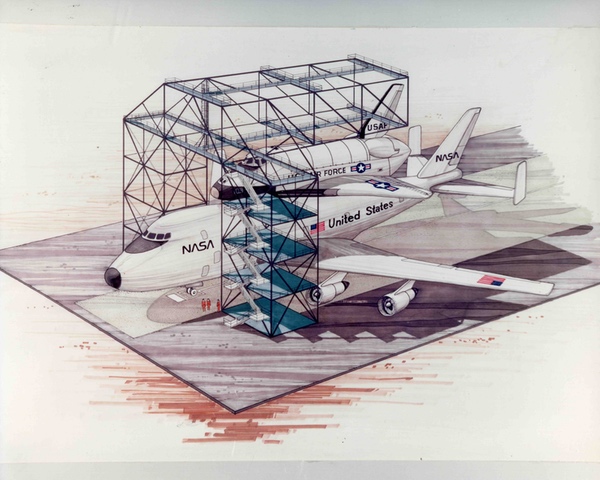 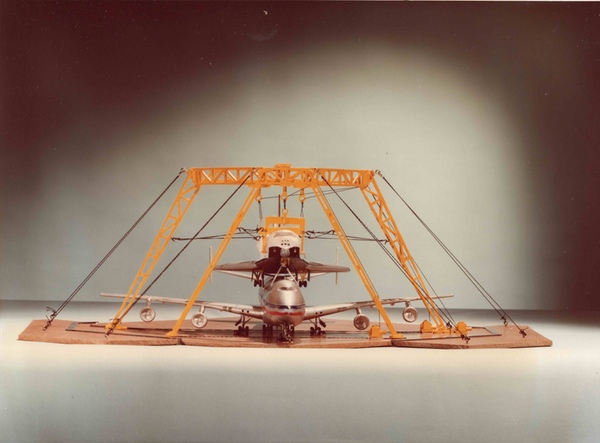 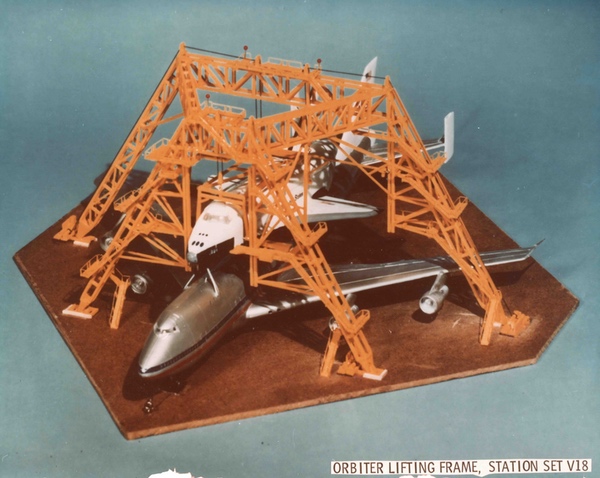 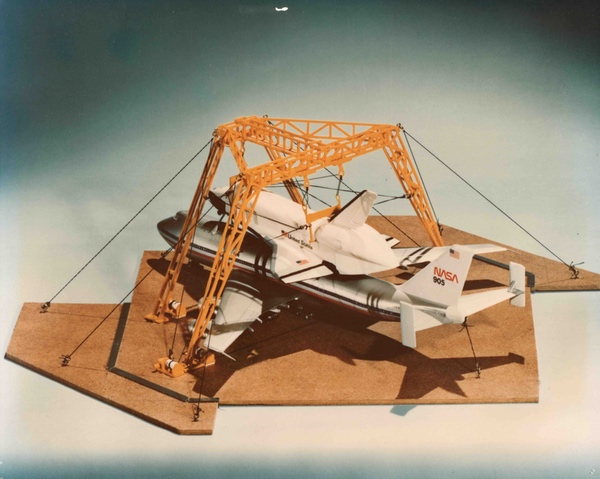 The shuttle was transported around the country on the back of a 747 Shuttle Carrier Aircraft. A large structure was required to lift it on and off the SCA at Vandenberg. (credit: USAF) |
An Orbiter Maintenance Facility would also be necessary to deal with the complicated spacecraft and its problematic thermal tiles. A crew support facility built on the main base in the 1960s for the MOL program would be renovated to support shuttle crews. A former MOL astronaut, Al Crews, said that the MOL astronauts expected to live on regular base housing until just before launch, when they would move to the crew quarters, which had a handball court because many of the MOL astronauts played handball. He did not think the crew facility was finished when the MOL program was canceled. Artwork of the building from the late 1970s shows a large exercise room at one end, with a ceiling much higher than necessary for normal exercise equipment, and consistent with a handball court. The building still exists today, but it is unknown what it is used for.
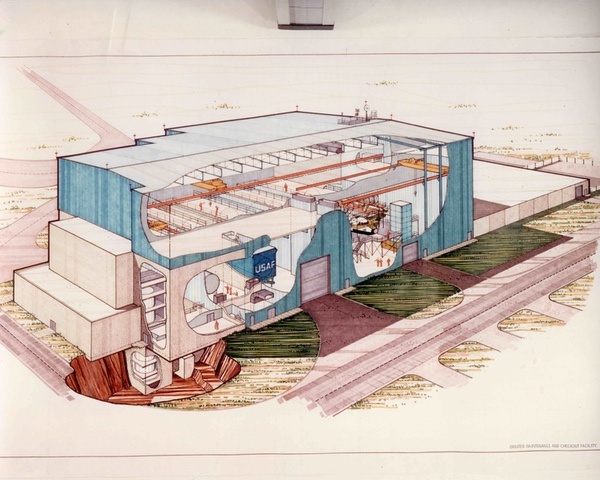 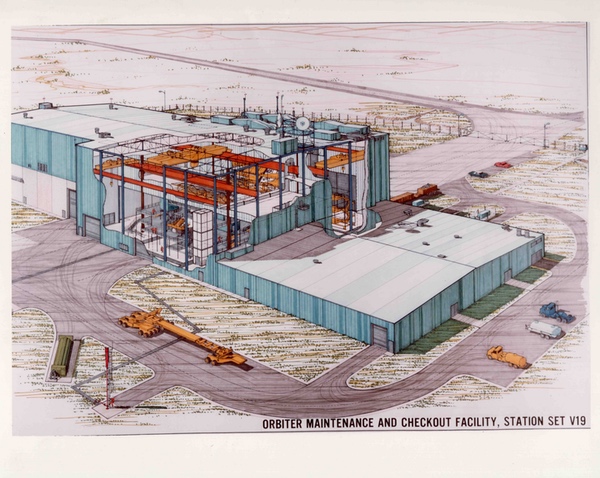 VThe shuttle orbiter was a complex vehicle requiring substantial ground support. NASA provided those facilities at Kennedy Space Center, but the Air Force had to build similar facilities at Vandenberg Air Force Base in the early 1980s. (credit: USAF) |
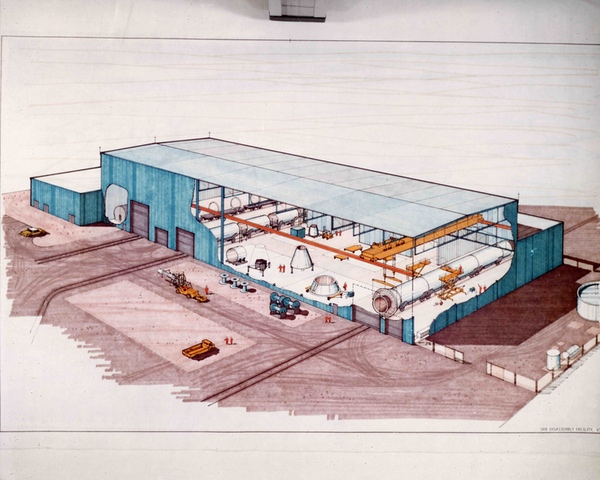 The SRBs were constructed in segments and would be taken apart at Port Hueneme. (credit: USAF) |
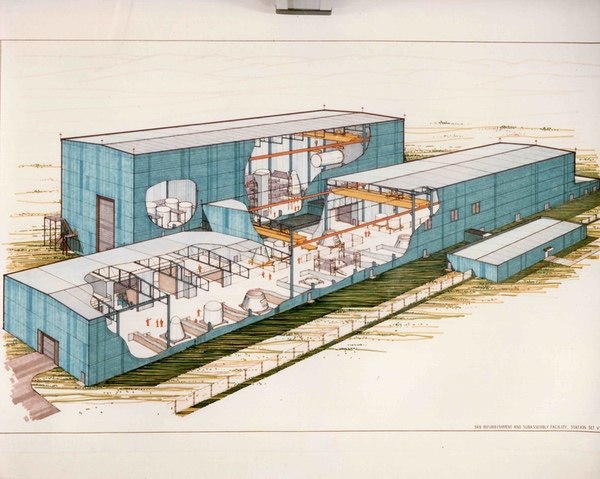 The shuttles Solid Rocket Boosters would be refurbished at Vandenberg, apparently being refilled with propellant. NASA chose to not perform refurbishment on site but to leave that to a contractor in Utah. (credit: USAF) |
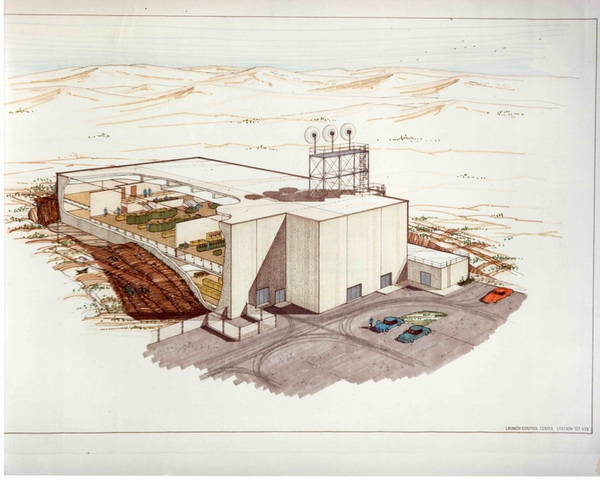 The shuttle would be the largest rocket launched at Vandenberg and require its own Launch Control Center located far from the launch pad. (credit: USAF) |
The construction at SLC-6 proceeded during the early 1980s and ran into numerous problems. A worker fell to his death, there were reports of drug use at the construction site, and there were various setbacks and unexpected delays. The site readiness slipped into late 1986, but all the major problems were fixed or nearly fixed at the end of 1985. But the January 1986 Challenger accident led the Air Force to halt construction and put the site into standby mode, then cancel plans to use it entirely after the expenditure of several billion dollars. Other than a brief period when it served as the launch site for a small rocket project, Slick-6 was mothballed for two decades until it was modified in the 2000s to support Delta IV Heavy launches.
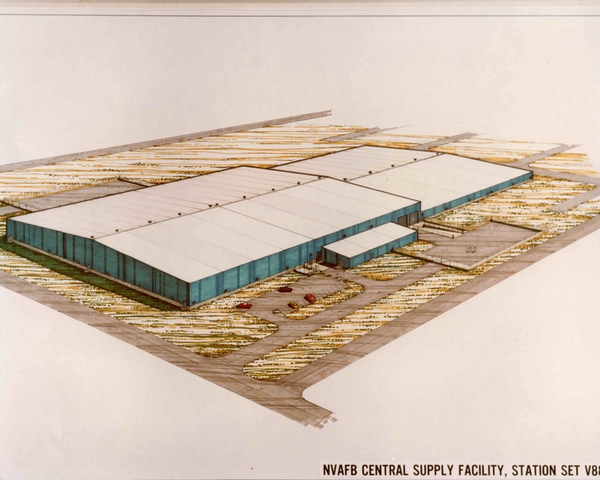 The shuttle was a complex system requiring many spare parts and support equipment. They required additional facilities at Vandenberg Air Force Base. (credit: USAF) |
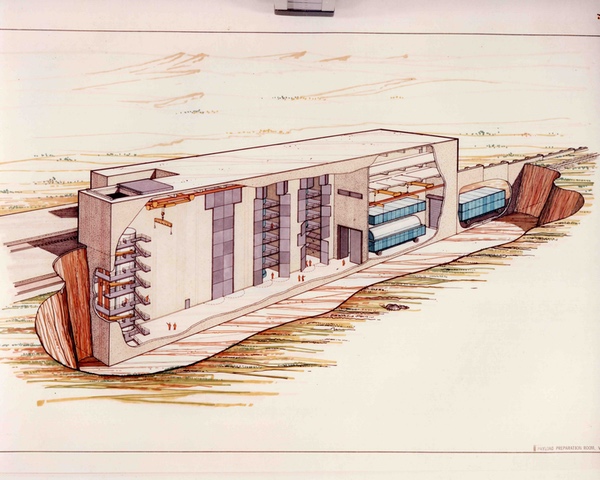 Vandenberg's shuttles would primarily carry highly classified reconnaissance payloads. This Payload Preparation Facility would be constructed partially below ground and have three vertical bays for payloads, with additional horizontal bays. (credit: USAF) |
Other shuttle facilities were eventually repurposed, although the relatively low launch rate at Vandenberg throughout the past three decades meant that they were never extensively used. The area with the external tank processing facility has recently been leased to Relativity Space for a launch site. SLC-6 has been leased to SpaceX, which plans to use it for Falcon 9 launches starting in 2025. The number of Vandenberg launches has increased substantially in recent years, adding energy to the base that it has not seen in decades. But for some long timers in the region, this is 40 years too late, long after the days when they envisioned shuttles roaring up over the mountains of central California.
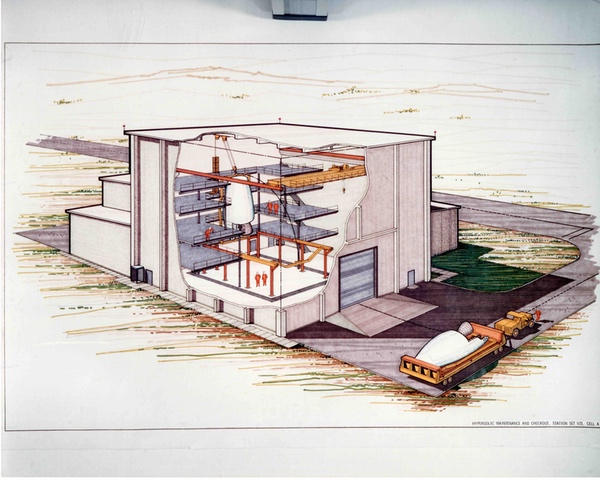 When planning for the shuttle at Vandenberg, there was a proposal to do hypergolic maintenance of the RCS thruster pods at the rear of the shuttle. (credit: USAF) |
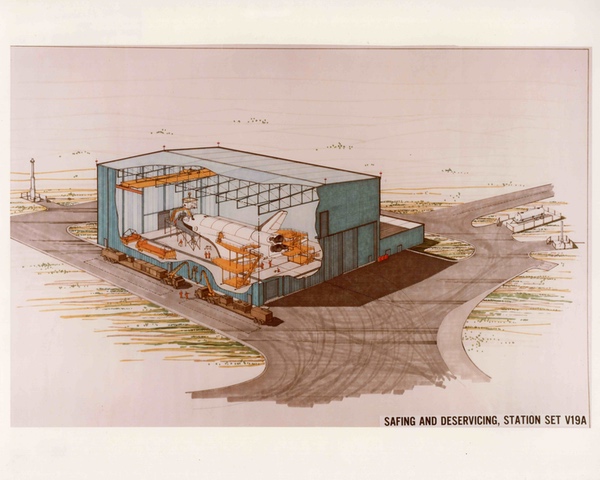 Safing and deservicing station for the orbiter. Note that in this artist depiction, the reaction control system with the thrusters at the front of the orbiter is being removed after flight. (credit: USAF) |
Note: we are now moderating comments. There will be a delay in posting comments and no guarantee that all submitted comments will be posted.